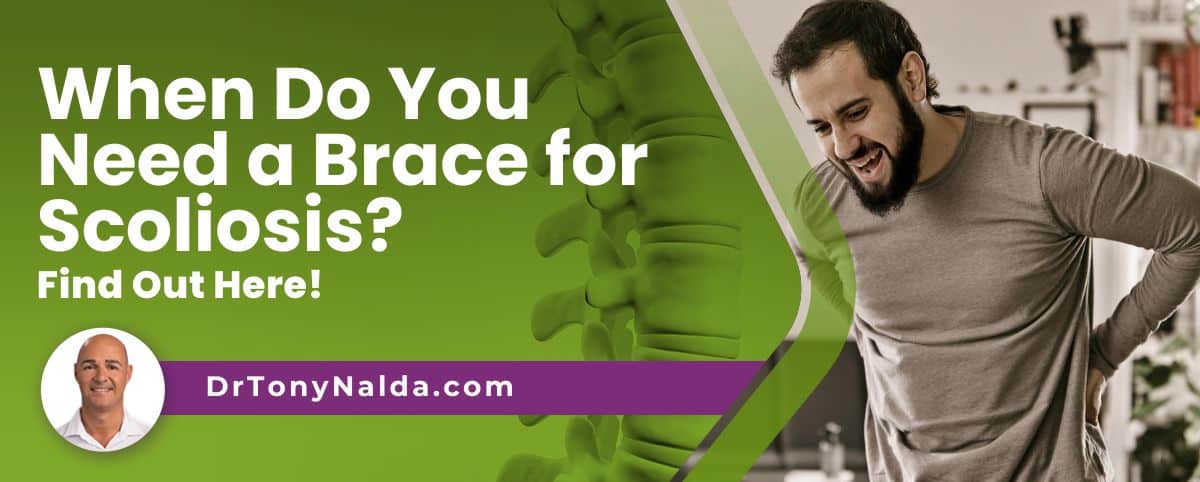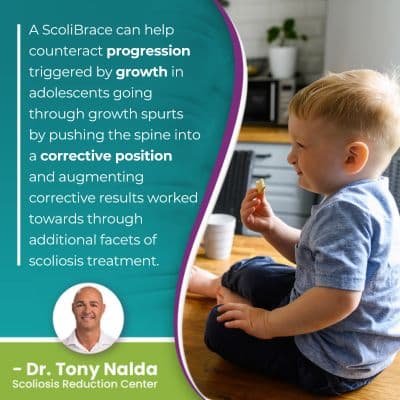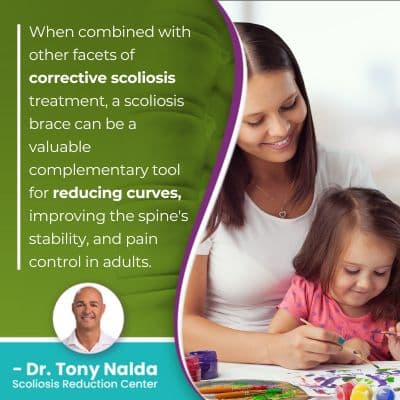When Do You Need a Brace for Scoliosis? Find Out Here!

There are different ways to address scoliosis, and when it comes to needing a scoliosis brace, they can serve different purposes among different age groups. In children, braces are integrated into treatment to complement other treatment disciplines that work towards correction, and for adults, scoliosis bracing is more about pain management and spinal stability.
Scoliosis braces are used to augment corrective treatment results by pushing the spine into a straighter alignment, and as braces are particularly effective on growing spines, a scoliosis brace is often needed as part of childhood scoliosis treatment.
No scoliosis brace on its own is capable of addressing a structural scoliotic curve, but as one facet of a conservative treatment plan, bracing can help correct scoliosis.
Table of Contents
What is Scoliosis?
Scoliosis is the development of an unnatural and unhealthy spinal curve.
Scoliotic curves bend to the side and rotate, making scoliosis a 3-dimensional structural spinal condition.
If scoliosis causes the loss of a healthy spinal curve, the spine responds by putting in unhealthy curves, and over time, this makes the spine increasingly unbalanced and unstable.
As a progressive condition, the nature of scoliosis is to get worse over time, and this means the size of the unnatural spinal curvature is increasing, as are the condition's uneven forces, and their effects.
Scoliosis ranges widely in severity from mild scoliosis to moderate scoliosis, severe and very-severe scoliosis, and as a progressive condition, where a scoliosis is at the time of diagnosis doesn't mean that's where it will stay.
Scoliosis affects all ages but is most commonly diagnosed in children as congenital scoliosis, infantile scoliosis, early-onset juvenile scoliosis, adolescent idiopathic scoliosis, and adult scoliosis is diagnosed once skeletal maturity has been reached.
There are also different types of scoliosis based on causation: idiopathic scoliosis, neuromuscular scoliosis, degenerative, and congenital scoliosis.
The most common type of scoliosis to affect all ages is idiopathic scoliosis, meaning not clearly associated with a single-known cause, and the most prevalent type of scoliosis overall is adolescent idiopathic scoliosis, so we'll focus on this type in the context of childhood scoliosis.
Adolescent Idiopathic Scoliosis
Adolescent idiopathic scoliosis is diagnosed between the ages of 10 and 18, and this age group is the most at risk for rapid-phase progression because of rapid growth; it's growth that triggers progression.
The rapid and unpredictable growth spurts of puberty have to be counteracted with treatment because the constant trigger of growth is occurring, and it's happening quickly.
As soon as an adolescent is diagnosed, treatment should be started because progression makes the condition more difficult to treat; as the curve gets larger, the spine gets increasingly rigid, and this makes it less responsive to treatment.
Increasing spinal rigidity can also make it difficult to perform certain key therapeutic exercises as part of treatment.
As scoliosis progresses, its effects are also becoming more noticeable and established; it's generally more effective to proactively work towards preventing progression and increasing effects than it is to attempt to reverse condition effects once they're established.
The main effect of adolescent idiopathic scoliosis include postural changes:
- Uneven shoulders
- Uneven shoulder blades
- The development of a rib cage arch
- Uneven hips
- Arms and legs that hang at different lengths
Additional changes to watch for can include changes to balance, coordination, and gait, and these effects get worse over time, particularly if left untreated, or not treated proactively.
As the spine is growing, it's more malleable and responsive to chiropractic care that works towards realigning the spine by adjusting the position of the curve's most-tilted vertebrae.
As the spine can be adjusted with chiropractic care, bracing treatment can help augment those changes by pushing the spine into a corrective position.
Bracing As Adolescent Idiopathic Scoliosis Treatment
 Here at the Scoliosis Reduction Center, my patients benefit from a proactive conservative scoliosis treatment approach that's started as close to the time of diagnosis as possible, when it's going to be at its mildest and most treatable.
Here at the Scoliosis Reduction Center, my patients benefit from a proactive conservative scoliosis treatment approach that's started as close to the time of diagnosis as possible, when it's going to be at its mildest and most treatable.
For most cases of adolescent idiopathic scoliosis, my brace of choice is the ultra-corrective ScoliBrace because of its corrective potential.
When it comes to bracing as a facet of childhood scoliosis treatment, the biggest challenge is compliance; no brace can be effective if it's not worn precisely as prescribed, and most adolescents don't comply with brace wear.
Adolescents don't want to stand out, walk differently, and have to wear a scoliosis brace that also makes certain activities difficult, if not impossible, to participate in.
Modern scoliosis bracing addresses many of the issues associated with traditional braces, such as compliance.
The ScoliBrace, when combined with condition-specific chiropractic care, physical therapy, and rehabilitation, can help achieve corrective results, which means the condition has been impacted on a structural level in the form of a curvature reduction, core strength has been increased through physical therapy and scoliosis-specific exercises so the spine is optimally supported/stabilized, and rehabilitation involves the prescription of scoliosis-specific exercises to further stabilize and heal the spine from home.
A ScoliBrace can help counteract progression triggered by growth in adolescents going through growth spurts by pushing the spine into a corrective position and augmenting corrective results worked towards through additional facets of scoliosis treatment.
ScoliBrace
The ultra-corrective ScoliBrace can augment corrective treatment results in children, but for adults, it's used more for pain management and increasing spinal stability.
Scoliosis doesn't become a compressive condition until skeletal maturity has been reached, so this is when it tends to become painful, and this can involve back pain, muscle pain, and/or pain that radiates into the extremities due to nerve compression.
Pain that radiates into the arms and hands is the main symptom that brings adults in to see me for a diagnosis and treatment.
The ScoliBrace is needed when a significant curvature reduction is the goal, and when it comes to childhood scoliosis, because of the constant progressive trigger of growth, reducing the curve significantly and holding the reduction throughout growth is the focus of treatment.
In the treatment of adult scoliosis, the goal includes reducing curves, but the reductions don't have to be as significant because there isn't growth to counteract, and the focus is to reduce adult scoliotic curves back to where they were before becoming painful.
 Additional goals of adult scoliosis bracing include increasing the spine's stability and pain management; the brace gives the spine structure so there is less movement within the parts of the spine, and this helps with pain.
Additional goals of adult scoliosis bracing include increasing the spine's stability and pain management; the brace gives the spine structure so there is less movement within the parts of the spine, and this helps with pain.
The ScoliBrace is modern and represents the culmination of what we've learned about scoliosis and bracing efficacy over the years.
The ScoliBrace doesn't squeeze the spine unnaturally as traditional bracing does, and it is also designed using state-of-the-art technology and scanning software so each brace is bespoke to its wearer, making braces more comfortable, easier to conceal under clothes, and has better rates of compliance.
When combined with other facets of corrective scoliosis treatment, a scoliosis brace can be a valuable complementary tool for reducing curves, improving the spine's stability, and pain control in adults.
Conclusion
Patients need scoliosis braces for different reasons: to reduce curves significantly in childhood scoliosis, to providing structural support/stability and pain management when treating adult scoliosis.
When a scoliosis brace is needed for children is when a significant curvature reduction, and counteracting growth, is the goal, and when a scoliosis brace is needed for adults is when conditions are painful and the spine's becoming increasingly unstable and unbalanced due to spinal degeneration and progression.
There are also different scoliosis braces to consider that are aligned with different scoliosis treatment approaches.
Traditional bracing and traditional scoliosis treatment is more about a reactive response to a diagnosis, and traditional braces for scoliosis are limited in their potential efficacy because they don't address scoliosis as a 3-dimensional condition, instead only addressing it as 2-dimensional.
Modern corrective bracing addresses the condition's true 3-dimensional nature, and as they are customized to address a patient's specific body/curvature type, compliance is improved; when it comes to the treatment of adolescent idiopathic scoliosis and the challenge of bracing, compliance is the biggest because adolescents don't want to stand out from their peers.
When scoliosis braces are needed is when the spine is still growing and bracing is recommended as part of a conservative and integrative treatment approach, and scoliosis braces are needed for adults for whom increasing spinal instability is an issue, along with pain.
Dr. Tony Nalda
DOCTOR OF CHIROPRACTIC
After receiving an undergraduate degree in psychology and his Doctorate of Chiropractic from Life University, Dr. Nalda settled in Celebration, Florida and proceeded to build one of Central Florida’s most successful chiropractic clinics.
His experience with patients suffering from scoliosis, and the confusion and frustration they faced, led him to seek a specialty in scoliosis care. In 2006 he completed his Intensive Care Certification from CLEAR Institute, a leading scoliosis educational and certification center.
About Dr. Tony Nalda
 Ready to explore scoliosis treatment? Contact Us Now
Ready to explore scoliosis treatment? Contact Us Now





